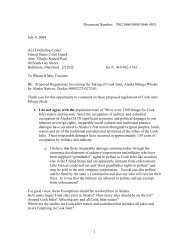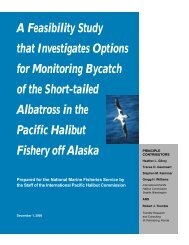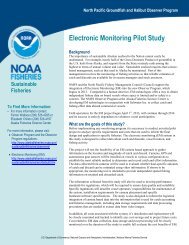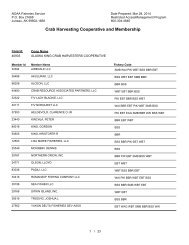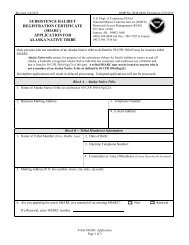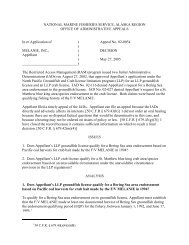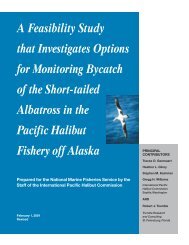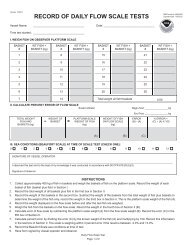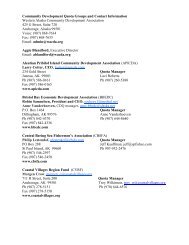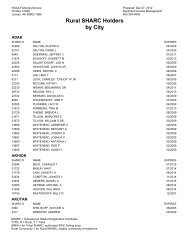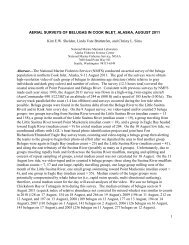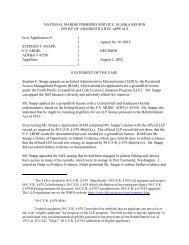Petition to List Lynn Canal Pacific Herring under the Endangered ...
Petition to List Lynn Canal Pacific Herring under the Endangered ...
Petition to List Lynn Canal Pacific Herring under the Endangered ...
You also want an ePaper? Increase the reach of your titles
YUMPU automatically turns print PDFs into web optimized ePapers that Google loves.
net air-sea CO2 exchange, fishery yields, and dominant basin-scale biological<br />
regimes.<br />
(Behrenfeld 2006: 754)(internal citations omitted). Oceanic food-web changes have<br />
already been documented in <strong>the</strong> North <strong>Pacific</strong>. These changes are implicated in <strong>the</strong><br />
severe decline of many species of fish and marine mammals.<br />
The “ocean climate hypo<strong>the</strong>sis” is an alternative explanation for <strong>the</strong> rapid changes<br />
that were observed <strong>to</strong> cross all trophic levels of <strong>the</strong> North <strong>Pacific</strong> (National<br />
Research Council 1996, Trites et al. in press). This bot<strong>to</strong>m-up hypo<strong>the</strong>sis is<br />
supported by a large and growing body of evidence (e.g., Ware and Thomson<br />
2005, Trites et al. in press). For <strong>the</strong> past 100 yr, 10–30-yr periods of stable<br />
physical conditions have been punctuated by rapid shifts <strong>to</strong> alternative stable<br />
physical oceanographic conditions (Ebbesmeyer et al. 1991, Graham 1994,<br />
Beamish et al. 2000, McKinnell et al. 2001, King 2005). These sudden and welldocumented<br />
“regime shifts” significantly affect sea temperatures, currents, and<br />
ice coverage—and correspond in space and time with ecosystem changes noted in<br />
Alaska and in British Columbia (Hare and Mantua 2000, Benson and Trites 2002,<br />
King 2005).<br />
(Trites et al. 2006). An ecological risk assessment performed on Cherry Point <strong>Herring</strong> by<br />
Landis et al. (2004) concluded that ocean conditions significantly affect <strong>Pacific</strong> <strong>Herring</strong>.<br />
An analysis of <strong>the</strong> Cherry Point <strong>Pacific</strong> herring age structure and population<br />
dynamics indicates that <strong>the</strong> loss of reproductive potential of <strong>the</strong> older age class<br />
fish was <strong>the</strong> population characteristic that led <strong>to</strong> <strong>the</strong> decline of <strong>the</strong> run.<br />
Exploitation, habitat alteration and climate change are <strong>the</strong> risk fac<strong>to</strong>rs that<br />
contribute <strong>to</strong> <strong>the</strong> decline of <strong>the</strong> Cherry Point <strong>Pacific</strong> herring. The retrospective<br />
assessment identified <strong>the</strong> cyclic nature of climate change, as expressed by <strong>the</strong><br />
warmer sea surface temperatures associated with a warm <strong>Pacific</strong> Decadal<br />
Oscillation (PDO), as <strong>the</strong> primary fac<strong>to</strong>r altering <strong>the</strong> dynamics of <strong>the</strong> <strong>Pacific</strong><br />
herring.<br />
(Landis et al. 2004).<br />
Reduced phy<strong>to</strong>plank<strong>to</strong>n productivity in <strong>the</strong> <strong>Lynn</strong> <strong>Canal</strong> area would have dire<br />
consequences for <strong>Pacific</strong> <strong>Herring</strong>. In particular, juvenile herring during <strong>the</strong> first winter<br />
are susceptible <strong>to</strong> environmental changes with little room for error <strong>to</strong> ensure survival.<br />
Marine perturbations that decrease food availability would inevitably cause greater winter<br />
mortality of juvenile herring, <strong>the</strong>reby depressing <strong>the</strong> future spawning generations.<br />
Cooney et al. (2001) found that juvenile herring were subject <strong>to</strong> substantial starvation<br />
losses during a winter period of plank<strong>to</strong>n diminishment.<br />
[W]e determined that if a juvenile herring arrives at <strong>the</strong> beginning of<br />
oceanographic winter in late November or early December with an energy content<br />
of 5.0 kJ/g and burns energy without supplemental feeding at 23 J/g day–1, it will<br />
57



